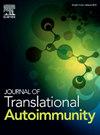Beyond conventional treatment: Novel cell therapies for systemic lupus erythematosus
IF 3.6
Q2 IMMUNOLOGY
引用次数: 0
Abstract
Systemic lupus erythematosus (SLE) is an autoimmune disease characterized by its heterogeneity, as it can affect various organs and exhibit a diverse clinical progression. The identification of SLE relies on the presence of distinct clinical manifestations in the skin, joints, kidneys, and the central nervous system, along with serological markers like antinuclear antibodies such as antibodies targeting dsDNA. The present therapeutic approaches for SLE encompass the use of antimalarial agents, glucocorticoids, immunosuppressive medications, and biological therapies. Despite the advancements in therapeutic strategies, SLE continues to be linked with adverse outcomes. The complicity and unpredictable nature of disease, characterized by episodes of relapses and remissions, coupled with the side effects of current treatment options, the progressive accumulation of organ damage, and persistent mortality rates despite therapeutic improvements, underscores the urgent necessity for the creation of innovative, effective, and specifically targeted therapies. Cell-based therapies, although still in their nascent stages, have attracted considerable interest in the realm of SLE treatment due to their potential for long-term disease suppression or even the possibility of a cure. Various cell types have emerged as promising candidates for SLE management. This review aims to provide a brief overview of the most recent research on novel cell-based therapeutic approaches that have progressed to either pre-clinical or clinical trial phases for the treatment of SLE.
超越传统治疗:系统性红斑狼疮的新细胞疗法
系统性红斑狼疮(SLE)是一种自身免疫性疾病,其特点是其异质性,因为它可以影响不同的器官,并表现出不同的临床进展。SLE的识别依赖于在皮肤、关节、肾脏和中枢神经系统中存在明显的临床表现,以及血清学标志物,如针对dsDNA的抗核抗体。目前SLE的治疗方法包括使用抗疟药、糖皮质激素、免疫抑制药物和生物疗法。尽管治疗策略取得了进步,但SLE仍然与不良后果有关。疾病的复杂性和不可预测性,以复发和缓解的发作为特征,加上目前治疗方案的副作用,器官损伤的逐渐积累,以及尽管治疗有所改善,但死亡率仍然存在,强调了迫切需要创造创新,有效和专门针对的治疗方法。基于细胞的疗法虽然仍处于初期阶段,但由于其长期疾病抑制甚至治愈的潜力,已经在SLE治疗领域引起了相当大的兴趣。各种细胞类型已成为SLE管理的有希望的候选者。本综述旨在简要概述最新的基于细胞的新型治疗方法的研究进展,这些研究已进展到治疗SLE的临床前或临床试验阶段。
本文章由计算机程序翻译,如有差异,请以英文原文为准。
求助全文
约1分钟内获得全文
求助全文
来源期刊

Journal of Translational Autoimmunity
Medicine-Immunology and Allergy
CiteScore
7.80
自引率
2.60%
发文量
33
审稿时长
55 days
 求助内容:
求助内容: 应助结果提醒方式:
应助结果提醒方式:


